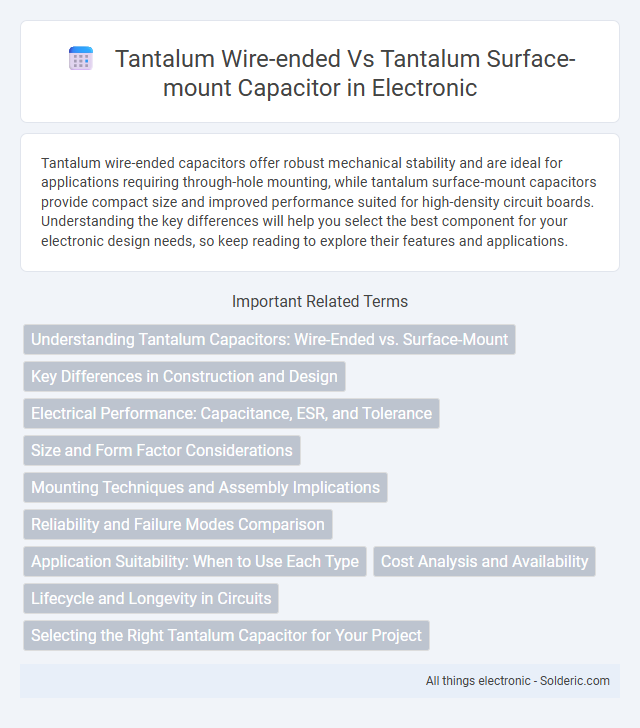Tantalum wire-ended capacitors offer robust mechanical stability and are ideal for applications requiring through-hole mounting, while tantalum surface-mount capacitors provide compact size and improved performance suited for high-density circuit boards. Understanding the key differences will help you select the best component for your electronic design needs, so keep reading to explore their features and applications.
Comparison Table
| Feature | Tantalum Wire-Ended Capacitor | Tantalum Surface-Mount Capacitor |
|---|---|---|
| Mounting Type | Through-hole (wire leads) | Surface-mount (SMD) |
| Size | Larger, bulkier | Compact, low profile |
| Assembly Process | Hand or machine soldering, manual insertion | Automated pick-and-place, reflow soldering |
| Frequency Performance | Better for low-frequency applications | Improved high-frequency response |
| Reliability | Robust mechanical connection | Susceptible to mechanical stress if improperly mounted |
| Applications | Prototyping, high-reliability circuits, power supply filtering | Consumer electronics, mobile devices, space-saving designs |
| Cost | Generally higher labor cost | Lower assembly cost, higher component cost |
Understanding Tantalum Capacitors: Wire-Ended vs. Surface-Mount
Tantalum wire-ended capacitors feature axial leads allowing easy through-hole PCB mounting, offering robust mechanical stability and higher capacitance values ideal for power filtering in harsh environments. Surface-mount tantalum capacitors provide compact, low-profile designs with superior frequency characteristics suitable for high-density circuit boards and automated assembly processes. Selection depends on application requirements, with wire-ended types preferred for durability and surface-mount versions optimized for miniaturization and high-frequency performance.
Key Differences in Construction and Design
Tantalum wire-ended capacitors feature wire leads for through-hole mounting, providing robust mechanical strength and easier manual soldering, whereas tantalum surface-mount capacitors are designed with flat terminations for automated placement on PCB surfaces, optimizing space and enabling high-density circuit designs. The wire-ended type typically uses a molded epoxy casing and offers better shock resistance, while surface-mount capacitors rely on chip-style construction with conductive end terminations, enhancing electrical performance and minimizing parasitic inductance. These distinct designs influence their suitability in various applications, with wire-ended capacitors favored for high-reliability, military, and aerospace uses, and surface-mount capacitors preferred in compact, high-frequency consumer electronics.
Electrical Performance: Capacitance, ESR, and Tolerance
Tantalum wire-ended capacitors typically offer higher capacitance values and lower Equivalent Series Resistance (ESR) compared to tantalum surface-mount capacitors, which are preferred for space-constrained applications. Surface-mount tantalum capacitors commonly feature tighter capacitance tolerances, often within +-5%, enhancing precision in high-frequency circuits. The ESR of wire-ended types, generally in the range of milliohms, supports better performance in power filtering, whereas surface-mount variants provide acceptable ESR with improved mechanical stability.
Size and Form Factor Considerations
Tantalum wire-ended capacitors typically have a larger size and bulkier form factor compared to tantalum surface-mount capacitors, which are designed for compact, space-saving applications. Surface-mount tantalum capacitors offer a low-profile, flat design ideal for high-density circuit boards where minimizing component size is critical. Your choice between these types should consider available board space and the mechanical constraints of your electronic assembly.
Mounting Techniques and Assembly Implications
Tantalum wire-ended capacitors utilize axial or radial leads for through-hole mounting, demanding drilled PCB holes and soldering that supports robust mechanical strength in high-vibration environments. In contrast, tantalum surface-mount capacitors rely on automated pick-and-place assembly with reflow soldering on flat PCB pads, enabling higher component density and faster production cycles. The choice between wire-ended and surface-mount tantalum capacitors impacts thermal management, assembly cost, and repairability within electronic devices.
Reliability and Failure Modes Comparison
Tantalum wire-ended capacitors exhibit superior mechanical robustness and are less prone to substrate-related stress failures compared to tantalum surface-mount capacitors, which often face risks from solder joint fatigue and board flexing. Both types share common failure modes such as dielectric breakdown and electrolyte degradation; however, surface-mount versions experience higher susceptibility to conductive anodic filament formation due to micro-cracks induced during reflow soldering. Reliability rates favor wire-ended tantalum capacitors in high-vibration or thermal cycling applications, while surface-mount types provide benefits in miniaturization despite potentially increased failure rates under harsh conditions.
Application Suitability: When to Use Each Type
Tantalum wire-ended capacitors are ideal for applications requiring high reliability and mechanical robustness, such as aerospace and military equipment, due to their excellent vibration resistance and long-term stability. Tantalum surface-mount capacitors are better suited for compact, high-density circuit designs like consumer electronics and telecommunications, where automated assembly and space-saving are critical. Your choice depends on balancing mechanical durability with miniaturization and manufacturing efficiency.
Cost Analysis and Availability
Tantalum wire-ended capacitors typically have higher manufacturing costs due to labor-intensive assembly and limited automation compared to tantalum surface-mount capacitors (SMCs), which benefit from mass production and streamlined processes. The availability of wire-ended tantalum capacitors is often constrained by lower demand and slower lead times, while tantalum SMCs enjoy broader market presence and extensive distributor networks ensuring faster and more reliable supply. Cost differences can reach up to 30-40%, with surface-mount tantalum capacitors being more cost-effective and readily available for high-volume electronics manufacturing.
Lifecycle and Longevity in Circuits
Tantalum wire-ended capacitors typically offer longer lifecycles due to their robust construction and superior resistance to mechanical stress, making them ideal for applications requiring high reliability over extended periods. In contrast, tantalum surface-mount capacitors provide excellent electrical performance but may be more susceptible to thermal stress and voltage spikes, which can affect their longevity in demanding circuits. Lifecycle performance depends on factors like operating temperature, voltage conditions, and circuit design, with wire-ended capacitors generally favored in environments where durability is critical.
Selecting the Right Tantalum Capacitor for Your Project
Selecting the right tantalum capacitor involves evaluating the specific requirements of your project, including size constraints, voltage ratings, and installation preferences. Wire-ended tantalum capacitors offer robust mechanical stability and are ideal for applications requiring through-hole mounting with high surge current capability. In contrast, tantalum surface-mount capacitors provide compact size, low equivalent series resistance (ESR), and are suited for automated PCB assembly in densely packed electronic circuits.
tantalum wire-ended vs tantalum surface-mount capacitor Infographic

 solderic.com
solderic.com